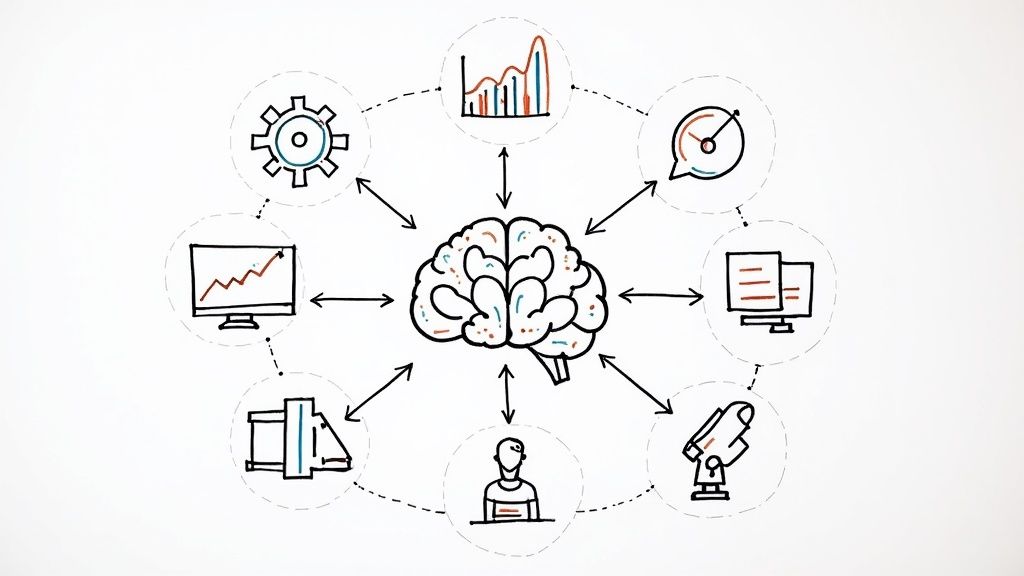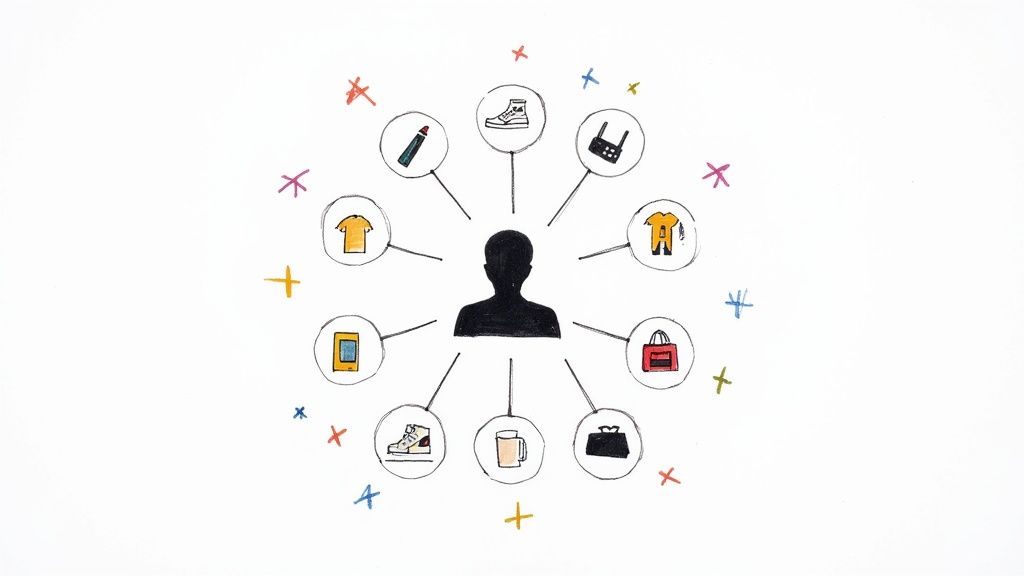8 Top AI Applications in Business Examples for 2025
Discover 8 powerful AI applications in business examples, from customer service to sales. Learn how to implement them for strategic growth and efficiency.

Artificial intelligence is no longer a futuristic concept; it's a critical tool driving real-world business results. While many companies are eager to adopt AI, success lies in identifying the right applications that solve tangible problems and create measurable value. This guide moves beyond generic discussions to provide a deep dive into 8 impactful AI applications in business examples. We'll explore not just what these technologies do, but how they are strategically implemented, offering a blueprint for your own AI journey.
From enhancing customer experience to optimizing complex supply chains, these real-world use cases showcase the power of strategic AI co creation. As we explored in our AI adoption guide, choosing the right use case is the first step toward impactful integration.
Partnering with an AI strategy consulting firm or using an AI Strategy consulting tool can help you pinpoint the highest-impact opportunities, ensuring your investment delivers a significant return. Each example in this article is broken down into a replicable strategy, offering actionable takeaways you can apply directly. Let's explore these practical applications and uncover how you can implement them.
1. Hyper-Personalized Customer Service with AI Chatbots
One of the most impactful ai applications in business examples is the deployment of AI-powered chatbots for hyper-personalized customer service. These are not the rigid, script-based bots of the past. Modern AI conversational agents use natural language processing (NLP) to understand customer intent, sentiment, and context, providing tailored, 24/7 support.
This technology automates routine inquiries, freeing human agents to focus on high-value, complex issues. For example, Bank of America's virtual assistant, Erica, successfully handles over 100 million client requests annually, from balance inquiries to transaction searches. Similarly, Sephora's chatbot offers personalized beauty advice and product recommendations, acting as a digital sales associate.
Strategic Breakdown
Implementing an AI chatbot isn't just about deflecting tickets; it's about enhancing the entire customer journey. The goal is to create a seamless support ecosystem where the AI handles the predictable, and humans manage the exceptional.
Key Insight: The most successful AI chatbots integrate deeply with CRM and e-commerce platforms. This allows them to access customer history, order data, and preferences to deliver truly personalized and context-aware responses, moving beyond generic FAQs.
Actionable Takeaways
To effectively leverage this technology, businesses should focus on a clear strategy.
- Start Small and Define Scope: Begin by identifying the top 3-5 most frequent and repetitive customer inquiries. Automate these first to ensure a quick win and gather performance data.
- Prioritize a Seamless Handoff: Design a clear and frictionless escalation path to a human agent. The chatbot should transfer the entire conversation history, so the customer never has to repeat themselves.
- Continuously Train Your AI: Use conversation logs and customer feedback to regularly refine the chatbot's understanding and responses. This iterative improvement is crucial for long-term success.
To understand how specific AI solutions can enhance customer service, explore its AI Chat features and see what's possible for your support team.
2. Predictive Analytics for Sales Forecasting
Another powerful entry in the list of ai applications in business examples is the use of predictive analytics for sales forecasting. This technology leverages AI algorithms to analyze historical sales data, market trends, customer behavior, and macroeconomic indicators. The result is a highly accurate prediction of future sales performance, enabling smarter, data-driven decisions.

This goes far beyond simple trend extrapolation. For instance, Amazon uses predictive analytics to anticipate regional demand, stocking warehouses with specific products before customers even order them. Similarly, Walmart’s sophisticated demand forecasting system analyzes everything from weather patterns to local events to optimize inventory, reportedly saving billions in holding costs.
Strategic Breakdown
Implementing predictive analytics is about shifting from reactive decision-making to a proactive, forward-looking strategy. The core objective is to reduce uncertainty in key business operations like inventory management, resource allocation, and revenue planning. This foresight is a significant competitive advantage.
Key Insight: The true power of predictive analytics emerges when it integrates diverse, seemingly unrelated datasets. By combining internal sales history with external factors like competitor pricing, social media sentiment, and economic reports, AI can uncover hidden correlations that drive forecast accuracy.
Actionable Takeaways
To effectively harness this AI capability, a structured approach is essential. A well-defined AI strategy consulting process can ensure your efforts are successful.
- Prioritize Data Quality: Before implementing any model, conduct a thorough audit of your historical data. Ensure it is clean, consistent, and comprehensive, as the quality of your predictions depends entirely on the quality of your input.
- Start with a Focused Scope: Begin with short-term forecasts (e.g., quarterly) for a specific product line or region. This allows you to validate the model's accuracy and build confidence before expanding to more complex, long-term predictions.
- Continuously Validate and Refine: Predictive models are not "set and forget." Regularly compare forecasts against actual results and use the variances to retrain and adjust your AI models, improving their precision over time.
3. Fraud Detection and Prevention
Another of the most critical ai applications in business examples is in real-time fraud detection and prevention. AI systems analyze vast datasets, including transaction details, user behavior, and network data, to identify anomalies that signal fraudulent activity. Unlike static, rule-based systems, these machine learning models continuously learn and adapt to new, sophisticated fraud tactics.
This capability is essential in the digital economy. For instance, Mastercard's AI-powered Decision Intelligence solution helps prevent an estimated $20 billion in fraud annually by analyzing transactions in real-time. Similarly, JPMorgan Chase leverages AI to scrutinize credit card transactions, detecting and flagging suspicious patterns that would otherwise go unnoticed by human analysts, protecting both the bank and its customers from significant losses.
Strategic Breakdown
Implementing AI for fraud prevention is about creating a dynamic, intelligent security layer that operates at scale. The goal is to move from reactive investigations to proactive threat mitigation, stopping fraud before it causes damage, all while maintaining a smooth customer experience.
Key Insight: The most effective AI fraud systems combine multiple data streams and machine learning models. This multi-layered approach allows them to identify subtle, correlated patterns across different channels that a single-model system would miss, dramatically improving detection accuracy and reducing false positives.
Actionable Takeaways
To build a robust AI-driven fraud detection framework, businesses must adopt a strategic approach.
- Balance Security with User Experience: Tune your models to minimize false positives. Overly aggressive systems can block legitimate customers, creating friction and damaging trust.
- Combine AI with Human Expertise: Use AI to flag high-risk activities, but empower a human team to review complex, ambiguous cases. This human-in-the-loop system leverages the best of both worlds.
- Continuously Update Models: Regularly retrain your AI with new, verified fraud data. Fraudsters constantly evolve their methods, and your defense system must evolve even faster.
For a deeper dive into how AI specifically combats financial crime, explore how AI Technology to Catch Chargeback Fraud can be used effectively. You can also learn more about how Ekipa's Verifai solution helps organizations build a stronger defense against emerging threats.
4. Recommendation Engines
One of the most profitable ai applications in business examples is the use of sophisticated recommendation engines. These AI systems analyze vast amounts of user data, including past behavior, preferences, and similar user profiles, to suggest relevant products, content, or services. By personalizing the user experience at scale, these engines are proven to significantly boost engagement and revenue.

This technology is the driving force behind the success of major digital platforms. For instance, Amazon's recommendation engine is estimated to generate 35% of its total revenue. Similarly, Netflix's algorithm influences approximately 80% of the content its users watch, while Spotify’s "Discover Weekly" playlist curates personalized music that keeps users deeply engaged on the platform.
Strategic Breakdown
Implementing a recommendation engine is about more than just showing related items. The strategic goal is to create a dynamic, self-improving discovery loop that increases customer lifetime value by consistently surfacing valuable and relevant content or products, often before the user even thinks to search for them.
Key Insight: The most advanced recommendation engines combine multiple AI approaches, such as collaborative filtering (what similar users like) and content-based filtering (what you've liked before). This hybrid model provides more accurate, diverse, and serendipitous recommendations, preventing the "filter bubble" effect where suggestions become too predictable.
Actionable Takeaways
To effectively leverage this powerful AI application, businesses need a focused approach.
- Start with Quality Data: Ensure you are collecting clean, relevant user interaction data. This includes views, purchases, ratings, and even time spent on a page. The quality of your recommendations is directly tied to the quality of your data.
- Provide Transparent Recommendations: Build user trust by explaining why a particular item is being recommended. Phrases like "Because you watched..." or "Customers who bought this also bought..." make the AI feel less like a black box and more like a helpful assistant.
- Continuously Test and Optimize: Recommendation algorithms are not "set and forget." Continuously A/B test different models and layouts to see what drives the most engagement and conversions. Use real-time user feedback to constantly refine the system's accuracy.
Developing an effective recommendation system requires a clear understanding of your business goals. For a deeper dive into defining your objectives, an AI requirements analysis can provide a structured starting point.
5. Supply Chain Optimization
Another of the most transformative ai applications in business examples is found in comprehensive supply chain optimization. AI systems analyze vast datasets, including historical sales, weather patterns, and global logistics, to forecast demand, manage inventory, and streamline operations. This predictive capability allows businesses to move from a reactive to a proactive supply chain strategy, significantly reducing costs and improving resilience.
This technology automates complex decision-making processes, enhancing efficiency from procurement to final delivery. For instance, DHL employs AI to optimize delivery routes in real-time, cutting fuel consumption by up to 15%. Similarly, Unilever leverages an AI-powered “digital twin” of its supply chain to reduce inventory levels by 20% while simultaneously improving customer service levels.
Strategic Breakdown
Implementing AI in the supply chain is about creating an intelligent, self-optimizing network. The goal is to gain end-to-end visibility and use predictive analytics to anticipate disruptions, balance inventory, and meet customer demand more effectively, a process that often starts with a detailed AI requirements analysis.
Key Insight: The true power of supply chain AI is unlocked through data integration. When AI systems can access and analyze siloed data from suppliers, logistics partners, and internal departments, they can identify hidden inefficiencies and optimization opportunities that are invisible to human planners.
Actionable Takeaways
To effectively leverage this technology, businesses must adopt a phased and strategic approach.
- Start with a Pilot Project: Identify a high-impact segment of your supply chain, such as demand forecasting or warehouse management. Launch a targeted pilot project to demonstrate ROI and build momentum for broader adoption.
- Prioritize Data Integration: Ensure clean, accessible data from all partners. Invest in platforms that can unify information from ERPs, warehouse management systems, and third-party logistics providers to create a single source of truth for the AI.
- Maintain Human Oversight: While AI can automate routing and inventory decisions, critical strategic choices require human expertise. Use AI as a powerful decision-support tool, empowering your team with data-driven recommendations rather than replacing them entirely.
6. Human Resources and Talent Management
Another of the most transformative ai applications in business examples is found within human resources, where AI is automating and optimizing the entire talent lifecycle. AI-driven platforms can sift through thousands of applications, identify top candidates based on skills and potential, and predict employee success with remarkable accuracy. This revolutionizes how companies attract, retain, and develop their workforce.
The impact is substantial. Unilever, for instance, uses AI to screen 1.8 million job applications annually, cutting its hiring time by an impressive 75%. Similarly, Hilton leverages AI-powered chatbots for initial candidate interviews, handling routine questions and allowing human recruiters to focus on more qualified applicants. These systems streamline tedious administrative work, enabling HR teams to become more strategic partners in the business.
Strategic Breakdown
Implementing AI in HR is about creating a more efficient, data-driven, and equitable talent management process. The objective is to use technology to augment human judgment, reduce unconscious bias, and improve key metrics like time-to-hire and employee retention. For a more in-depth look at optimizing the initial stages of hiring, consider how automated candidate screening with AI tools can pinpoint the best applicants faster.
Key Insight: The true power of AI in HR lies in its predictive capabilities. By analyzing performance data, engagement surveys, and career progression, systems like IBM Watson Talent can identify employees at risk of leaving, allowing management to intervene proactively.
Actionable Takeaways
To effectively integrate AI into your HR functions, adopt a measured and ethical approach.
- Audit for Fairness: Regularly audit your AI systems to ensure they are not perpetuating or creating bias in hiring or promotion decisions. This is crucial for both compliance and building a diverse workforce.
- Maintain Human Oversight: Use AI as a decision-support tool, not a replacement for human judgment. Final hiring, promotion, and termination decisions should always involve experienced HR professionals.
- Align with Performance Goals: Connect AI-driven talent insights with business objectives. By integrating performance management with tools like an OKR management system, you can ensure talent development directly supports key company results.
7. Dynamic Pricing and Revenue Management
Another one of the most transformative ai applications in business examples is the use of AI for dynamic pricing and revenue management. This approach moves beyond static pricing models, using machine learning algorithms to adjust prices in real-time based on a multitude of factors, including market demand, competitor pricing, inventory levels, customer behavior, and even external events like weather or holidays.
This technology empowers businesses to maximize profitability while staying competitive. For instance, ride-sharing giant Uber’s surge pricing adjusts fares based on rider demand and driver availability. Similarly, airlines like Delta and hotel chains use sophisticated AI to optimize pricing across thousands of flights and rooms daily, ensuring they capture the maximum possible revenue for each available asset.
Strategic Breakdown
Implementing AI-driven pricing is not just about raising prices when demand is high; it is about finding the optimal price point that balances revenue, customer acquisition, and long-term brand perception. The goal is to create a responsive pricing engine that adapts instantly to a fluctuating marketplace, maximizing yield from perishable inventory or high-demand products.
Key Insight: The most advanced dynamic pricing systems incorporate customer lifetime value (CLV) into their models. Instead of optimizing for a single transaction, the AI considers how a specific price might impact a customer's future purchasing behavior, offering strategic discounts to high-value segments to encourage loyalty.
Actionable Takeaways
To successfully leverage dynamic pricing, businesses need a carefully considered strategy that protects brand equity.
- Establish Clear Pricing Boundaries: Define strict minimum and maximum price floors and ceilings. This prevents the AI from setting prices that could damage your brand's reputation or alienate your customer base during extreme market shifts.
- Monitor Competitor and Market Signals: Integrate real-time data feeds for competitor pricing and market trends. The AI's effectiveness is directly tied to the quality and timeliness of the data it receives to make informed decisions.
- Test and Segment Before Full Rollout: Pilot new pricing algorithms on small, specific customer segments or product lines first. Analyze the impact on conversion rates and revenue before deploying the strategy across the entire business.
To effectively manage and visualize the financial impact of such strategies, businesses can track key metrics using a Financial Insights Dashboard to see how pricing changes affect overall revenue.
8. Intelligent Document Processing and Automation
A powerful but often overlooked entry among ai applications in business examples is Intelligent Document Processing (IDP). This technology transcends simple Optical Character Recognition (OCR) by using AI, natural language processing (NLP), and machine learning to understand, classify, extract, and process data from unstructured documents like invoices, contracts, and emails, turning manual data entry into an automated workflow.
IDP systems can dramatically reduce manual labor and accelerate core business functions. For instance, JPMorgan's COIN platform processes complex legal documents in seconds, a task that previously took 360,000 hours annually. Similarly, Siemens automates the processing of over one million invoices per year, while insurance firms like State Farm use IDP to analyze and approve claims documents almost instantly, revolutionizing their operational efficiency.
Strategic Breakdown
Implementing IDP is about transforming data-intensive, manual processes into streamlined, automated workflows. The strategic goal is to unlock the value trapped in unstructured documents, improve data accuracy, and reallocate human capital to more analytical and strategic tasks.
Key Insight: The true power of IDP is realized when it is integrated into end-to-end business process automation. It acts as the crucial first step, digitizing and structuring data so that it can flow seamlessly into other systems like ERPs, CRMs, and robotic process automation (RPA) bots.
Actionable Takeaways
To successfully deploy IDP, a phased and strategic approach is essential for maximizing ROI.
- Target High-Volume, Standardized Documents: Begin with processes that involve a large volume of similar documents, such as invoice processing or employee onboarding forms. This ensures a faster return on investment and provides a clear use case for expansion.
- Prioritize Data Quality: Ensure high-quality document scans and digital inputs. The accuracy of AI-driven extraction is directly correlated with the quality of the source document.
- Implement a Human-in-the-Loop: For critical or highly variable documents, design a workflow where AI handles the initial processing, flagging exceptions or low-confidence extractions for human review. This balances automation with accuracy.
Developing a robust IDP system is a core component of digital transformation. A proper AI requirements analysis can help define the scope and technical needs for such a project.
AI Business Applications: 8-Point Comparison
AI Application Implementation Complexity Resource Requirements Expected Outcomes Ideal Use Cases Key Advantages
Customer Service Chatbots
Moderate to high; 3-6 months setup
Requires NLP expertise, CRM integration
30-50% cost reduction, 24/7 support
Customer support, FAQs, multilingual service
Instant responses, cost savings, scalability
Predictive Analytics for Sales
High; complex ML and data needs
High-quality historical data, ML models
20-50% more accurate forecasts
Retail, manufacturing, financial planning
Improved forecasting, proactive decisions
Fraud Detection and Prevention
High; significant initial investment
Real-time monitoring, continuous tuning
60-90% fraud loss reduction, fewer false positives
Banking, e-commerce, insurance
Real-time detection, adaptive learning
Recommendation Engines
Moderate; ongoing optimization
Large user data, integration with platforms
10-30% revenue increase, 200-300% CTR lift
E-commerce, streaming, content platforms
Personalized recommendations, increased engagement
Supply Chain Optimization
High; complex integration
Clean, integrated supply chain data
15-25% cost reduction, 10-20% delivery improvement
Logistics, inventory, supplier management
Cost savings, efficiency, risk management
Human Resources and Talent Management
Moderate; bias and compliance focus
Employee data, predictive analytics
50-75% faster hiring, 15-25% retention boost
Recruitment, performance management
Time saving, better matching, retention
Dynamic Pricing and Revenue Management
High; complex real-time algorithms
Market data, competitor prices
5-25% revenue increase, 10-40% profit margin
Retail, travel, e-commerce pricing
Revenue optimization, rapid market response
Intelligent Document Processing
Moderate to high; initial training
OCR, NLP tools, system integration
80-90% reduction in processing time
Invoice processing, legal, insurance claims
Accuracy, cost reduction, 24/7 automation
From Examples to Execution: Building Your AI Strategy
The journey through these diverse AI applications in business examples reveals a powerful, unifying theme: artificial intelligence is no longer a futuristic concept but a practical, results-driven business tool. From enhancing customer service with intelligent chatbots to optimizing supply chains with predictive logistics, the true value of AI emerges not from the technology itself, but from its strategic application to solve specific, core business challenges. The success stories we've explored are not accidents; they are the result of clear vision, meticulous planning, and a commitment to data-driven decision-making.
The common thread linking a successful recommendation engine to a robust fraud detection system is the initial focus on a well-defined problem. Rather than adopting AI for its own sake, leading organizations identify a critical pain point, such as high operational costs, inaccurate sales forecasts, or inefficient manual workflows, and then apply the right AI solution to address it. This problem-first approach is fundamental to achieving a measurable return on investment.
Your Roadmap to AI Implementation
Translating these insights into a tangible plan for your own organization is the crucial next step. The path from inspiration to execution involves a series of deliberate actions that build on one another. As we explored in our AI adoption guide, a structured approach mitigates risk and maximizes the potential for success.
Here are the actionable takeaways to guide your strategy:
- Start with a Strategic Audit: Before diving into technology, conduct a thorough analysis of your business operations. Identify the most significant bottlenecks, inefficiencies, or opportunities for growth. Where could automation or predictive insights deliver the greatest impact? This foundational step is a core component of any effective AI requirements analysis.
- Prioritize a High-Impact Use Case: You don't need to revolutionize your entire business overnight. Select one or two of the real-world use cases discussed, like intelligent document processing or sales forecasting, that align with your immediate goals. A successful pilot project builds momentum and provides a compelling business case for broader adoption.
- Develop a Data-First Culture: Every example highlighted in this article is powered by data. Ensure your data is clean, accessible, and relevant to the problem you are trying to solve. Fostering a culture that values data integrity is a prerequisite for any meaningful AI initiative.
Mastering these concepts is no longer optional; it's a competitive necessity. The ability to identify, plan, and execute an AI strategy will define market leaders in the coming years. By moving from passively observing AI applications in business examples to actively building your own, you position your organization to not just survive but thrive in an increasingly intelligent world. Your journey begins with a single, well-chosen step, guided by a clear strategy developed through AI co creation.
Ready to move beyond examples and build a tangible AI roadmap for your business? At Ekipa AI, we specialize in transforming ideas into scalable, high-impact AI solutions. Get your personalized Custom AI Strategy report to identify the most valuable AI opportunities for your unique challenges and start your journey toward intelligent transformation. If you have any questions, feel free to reach out to our expert team.



